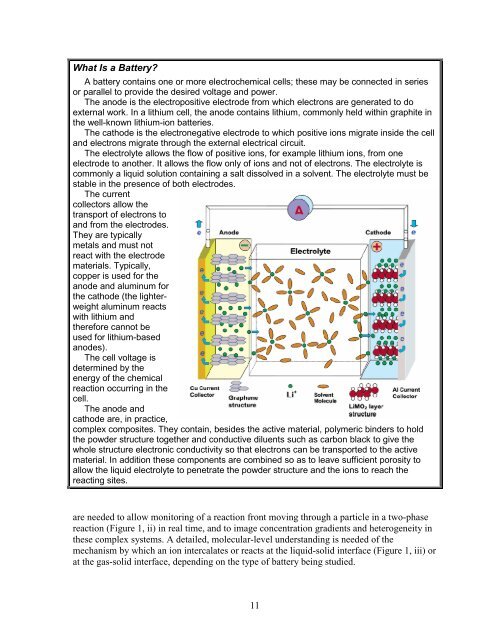Basic Research Needs for Electrical Energy Storage: Report of the ...
Basic Research Needs for Electrical Energy Storage: Report of the ...
Basic Research Needs for Electrical Energy Storage: Report of the ...
Create successful ePaper yourself
Turn your PDF publications into a flip-book with our unique Google optimized e-Paper software.
What Is a Battery?<br />
A battery contains one or more electrochemical cells; <strong>the</strong>se may be connected in series<br />
or parallel to provide <strong>the</strong> desired voltage and power.<br />
The anode is <strong>the</strong> electropositive electrode from which electrons are generated to do<br />
external work. In a lithium cell, <strong>the</strong> anode contains lithium, commonly held within graphite in<br />
<strong>the</strong> well-known lithium-ion batteries.<br />
The cathode is <strong>the</strong> electronegative electrode to which positive ions migrate inside <strong>the</strong> cell<br />
and electrons migrate through <strong>the</strong> external electrical circuit.<br />
The electrolyte allows <strong>the</strong> flow <strong>of</strong> positive ions, <strong>for</strong> example lithium ions, from one<br />
electrode to ano<strong>the</strong>r. It allows <strong>the</strong> flow only <strong>of</strong> ions and not <strong>of</strong> electrons. The electrolyte is<br />
commonly a liquid solution containing a salt dissolved in a solvent. The electrolyte must be<br />
stable in <strong>the</strong> presence <strong>of</strong> both electrodes.<br />
The current<br />
collectors allow <strong>the</strong><br />
transport <strong>of</strong> electrons to<br />
and from <strong>the</strong> electrodes.<br />
They are typically<br />
metals and must not<br />
react with <strong>the</strong> electrode<br />
materials. Typically,<br />
copper is used <strong>for</strong> <strong>the</strong><br />
anode and aluminum <strong>for</strong><br />
<strong>the</strong> cathode (<strong>the</strong> lighterweight<br />
aluminum reacts<br />
with lithium and<br />
<strong>the</strong>re<strong>for</strong>e cannot be<br />
used <strong>for</strong> lithium-based<br />
anodes).<br />
The cell voltage is<br />
determined by <strong>the</strong><br />
energy <strong>of</strong> <strong>the</strong> chemical<br />
reaction occurring in <strong>the</strong><br />
cell.<br />
The anode and<br />
cathode are, in practice,<br />
complex composites. They contain, besides <strong>the</strong> active material, polymeric binders to hold<br />
<strong>the</strong> powder structure toge<strong>the</strong>r and conductive diluents such as carbon black to give <strong>the</strong><br />
whole structure electronic conductivity so that electrons can be transported to <strong>the</strong> active<br />
material. In addition <strong>the</strong>se components are combined so as to leave sufficient porosity to<br />
allow <strong>the</strong> liquid electrolyte to penetrate <strong>the</strong> powder structure and <strong>the</strong> ions to reach <strong>the</strong><br />
reacting sites.<br />
are needed to allow monitoring <strong>of</strong> a reaction front moving through a particle in a two-phase<br />
reaction (Figure 1, ii) in real time, and to image concentration gradients and heterogeneity in<br />
<strong>the</strong>se complex systems. A detailed, molecular-level understanding is needed <strong>of</strong> <strong>the</strong><br />
mechanism by which an ion intercalates or reacts at <strong>the</strong> liquid-solid interface (Figure 1, iii) or<br />
at <strong>the</strong> gas-solid interface, depending on <strong>the</strong> type <strong>of</strong> battery being studied.<br />
11
















